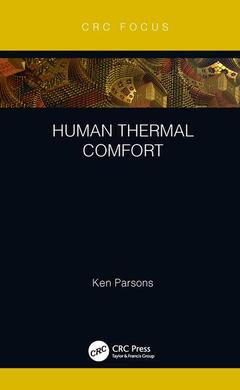Description
Human Thermal Comfort
Author: Parsons Ken
Language: English
Subjects for Human Thermal Comfort:
Keywords
Thermoregulation; Node Model; Adaptive Thermal Comfort; PMV; Predicted Mean Vote; Psycho-Phsiological; Local Thermal Sensation; Spinal Cord; Adaptive Thermal Comfort Model; Thermal Comfort; Thermal Sensation Responses; Outdoor Thermal Environments; ASHRAE Scale; Ppd Index; PMV Index; Local Thermal Discomfort; Adaptive Opportunities; Relative Air Velocity; Clothing Insulation; PMV Equation; UTCI; Plane Radiant Temperature; Thermal Comfort Survey; Thermal Comfort Index; Thermal Comfort Requirements; Spina Bifida; Comfort Equation; Thermal Comfort Conditions; Direct Solar Radiation; Skin Wettedness
· 13.8x21.6 cm · Hardback
Description
/li>Contents
/li>Readership
/li>Biography
/li>
Thermal comfort is a desirable state familiar to all people. Providing inspirational indoor and outdoor environments that provide thermal comfort, in the context of energy use and climate change, is a challenge for the 21st century. This book provides an up-to-date, comprehensive coverage of thermal comfort from principles and theory to practical application.
The book begins with current knowledge and understanding of thermal comfort and its application to providing thermal conditions for indoor and outdoor environments. It integrates and presents new ideas to provide a comprehensive model of thermal comfort so that we can move on from the 20th and early 21st century and provide a focus for developments for future decades.
This book will be of interest to practitioners and students and anyone involved with fields such as environmental design, physiology, ergonomics, human factors, industrial hygiene, architecture, health and safety and air conditioning.
? Provides current thermal comfort standards and regulations
? Describes the PMV, PPD, ET* and SET thermal comfort indices
? Discusses adaptive thermal comfort, adaptive opportunity and explains why we have not moved towards a more dynamic and interactive approach to providing thermal comfort
? Presents a new model relating thermal discomfort to performance
? Shows how to construct a computer model of thermal comfort
? Offers how to conduct a thermal comfort survey
Human Thermal Comfortprovides new ideas for achieving thermal comfort for offices, vehicles, atriums, and plazas of the future.
Ken Parsons is Emeritus Professor of Environmental Ergonomics at Loughborough University. He has spent over 30 years conducting laboratory and field research into human thermal comfort. He was born on January 20, 1953, in northeast England in a coastal village called Seaton Sluice. He graduated from Loughborough University in ergonomics in 1974, obtained a postgraduate certificate in education in mathematics with a distinction from Hughes Hall, Cambridge University in 1975 and was awarded a PhD in human response to vibration in 1980, from the Institute of Sound and Vibration Research, Southampton University. He founded the Human Thermal Environments Laboratory at Loughborough in 1981 and was awarded a certificate in management from the Open University in 1993. Ken became head of the Department of Human Sciences in 1996 covering research and teaching in ergonomics, psychology and human biology. He was Dean of Science in 2003 and pro-vice chancellor for research from 2009 to 2012. He was chair of the United Kingdom Deans of Science from 2008 to 2010.
In 1992, he received the Ralph G. Nevins award from the American Society of Heating, Refrigerating and Air-Conditioning Engineers (ASHRAE) for ‘significant accomplishments in the study of bioenvironmental engineering and its impact on human comfort and health’. The Human Thermal Environments laboratory was awarded the President’s Medal of the Ergonomics Society in 2001. He is one of the co-authors of the British Occupational Hygiene Society publication on thermal environments and has contributed to the Chartered Institute of Building Services Engineers publications on thermal comfort as well as to the ASHRAE Handbook: Fundamentals.
He has been a fellow of the Institute of Ergonomics and Human Factors, the International Ergonomics Association and the Royal Society of Medicine. He was a registered European Ergonomist and an elected member to the council of the Ergonomics Society. He h




